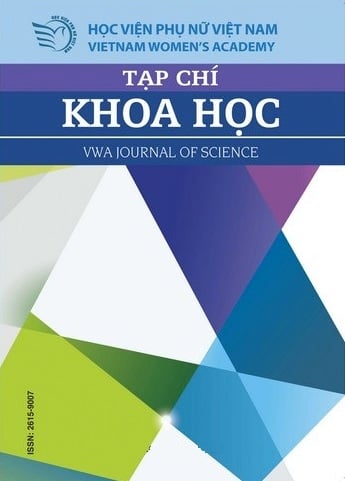[1] Đào Lê Hòa An (2013). Nghiên cứu về hành vi sử dụng Facebook của con người – Một thách thức mới cho tâm lý học hiện đại. Tạp chí Khoa học Đại học Sư phạm Thành phố Hồ Chí Minh, số 49 năm 2013.
[2] Đoàn Thùy Dương (2014). Sinh viên và mạng xã hội Facebook- Một phân tích về sự tiến triển vốn xã hội. Luận văn Thạc sĩ, Trường Đại học Khoa học xã hội và Nhân văn, Đại học Quốc gia Hà Nội.
[3] Đặng Hoàng Minh &Lê Thị Phương (2013). Tương quan giữa mức độ sử dụng Internet và các vấn đề sức khỏe tâm thần của học sinh Trung học cơ sở. Tạp chí Khoa học ĐHQGHN, Nghiên cứu Giáo dục. Tập 29, Số 2 (2013) 34‐42.
[4] Nguyễn Thị Kim Hoa & Nguyễn Lan Nguyên (2016). Tác động của mạng xã hội Facebook đối với sinh viên hiện nay. Tạp chí Khoa học Đại học Quốc gia Hà Nội, Nghiên cứu Chính sách và Quản lý, tập 32, số 2 năm 2016, tr 68-74.
[5] Nguyễn Thị Lan Hương (2018). Thực trạng sử dụng mạng xã hội của thanh, thiếu niên ở Việt Nam hiện nay. Tạp chí Văn hóa nghệ thuật số 407, tháng 5 – 2018
[6] Phạm Thị Liên (2016). Hoạt động sử dụng mạng Internet của học sinh trung học phổ thông nông thôn. Luận văn Thạc sĩ, Trường Đại học Khoa học xã hội và nhân văn, Đại học Quốc gia Hà Nội.
[7] Phạm Văn Quyết (2007). Truyền thông thay đổi hành vi – những kinh nghiệm từ việc triển khai một dự án. Tạp chí Tâm lý học số 8 (101)
[8] Lý Thị Trang, Dương Thùy Linh & Phùng Thị Hiền (2019). Kỹ năng sử dụng mạng xã hội an toàn của học sinh THCS tại Thành phố Hà Nội hiện nay. Đề tài Nghiên cứu khoa học sinh viên cấp Học viện Thanh thiếu niên Việt Nam.
[9] Trần Văn Công, Nguyễn Phương Hồng Ngọc, Ngô Thùy Dương & Nguyễn Thị Thắm. (2015). Chiến lược ứng phó của học sinh với bắt nạt trực tuyến. Tạp chí Khoa học ĐHQGHN: Nghiên cứu Giáo dục, Tập 31, Số 3 (2015) 11-24 11
[10] Trần Thị Minh Đức & Bùi Thị Hồng Thái (2014). Sử dụng mạng xã hội trong sinh viên Việt Nam. Tạp chí Khoa học Xã hội Việt Nam số 8, 2014.
[11] World Vision & Viện Nghiên cứu Quản lý phát triển bền vững (2018). Tài liệu hướng dẫn sinh hoạt Câu lạc bộ Công dân số chuẩn – Sử dụng Internet thông minh và an toàn cho thanh thiếu niên và trẻ em.
[12] World Vision, Viện Nghiên cứu Quản lý phát triển bền vững (2018). Cẩm nang dành cho cha mẹ thời đại công nghệ số, đồng hành cùng con sử dụng Internet an toàn.
[13] Dor, A., Weimann-Saks, D. (2013). Children’s Facebook Usage: Parental Awareness, Attitudes and Behavior, Studies in Media and Communication, Vol. 1, No. 1, June 2013.
[14] Akhter, N. (2013). Relationship between Internet Addiction and Academic Performance among University Undergraduates. Journal of Science and Technology Education Research, 8(19), 1793-1796.
[15] Bandura, Albert (1977). Social foundations of thought and action: A social cognitive theory. Engelwood Cliffs. NJ: Prentice – Hall.
[16] Bandura, Albert (1977). Social learning theory. New York: General Press
[17] Brown et al. (2014). The Influence of Internet Usage on Academic Performance and Face-to Face Communication. Journal of Psychology and Behavioral Science, 2(2), 163-186.
[18] Claire Lilley, Ruth Ball and Heather Vernon (2014). The Experiences of Children Aged 11-16 on Social Networking Sites. National Society for the Prevention of Cruelty to Children (NSPCC).
[19] Ellen Vanderhoven, Tammy Schellens, Martin Valcke, Annelies Raes (2014). How Safe Do Teenagers Behave on Facebook? An Observational Study. PLoS One 2014; 9(8): e104036. Published online 2014 Aug 27. doi: 10.1371/journal.pone.0104036
[20] Elihu Katz (1957). The Two-Step Flow of Communication: An Up-To-Date Report on an Hypothesis. Public Opinion Quarterly, 21 (1), Spring 1957, PP 61–78
[21] Fionnbar Lenihan (2007). Computer addiction - a skeptical view. Advances in Psychiatric Treatment.
[22] Metzger et al. (2003). College students web use, perceptions of information credibility and verification behavior. Computers and Education, 41, PP.271-290
[23] Suhail et al. (2006). Effects of excessive internet use on undergraduate students in Pakistan. Cyber Psychology and Behavior, 9(3), PP.297-307.
[24] Vaibhav Sarangale; Shishira Hegde. Research to enhance experience of Indian Social Networking Site. IES Management College and Research Center, Mumbai.
[25] We are Social Hootsuite (2019). Global Report Digital. https://drive.google.com/file/d/1y3iff0wZ5fubyTDPm pei4SMtZth4sQD3/view
